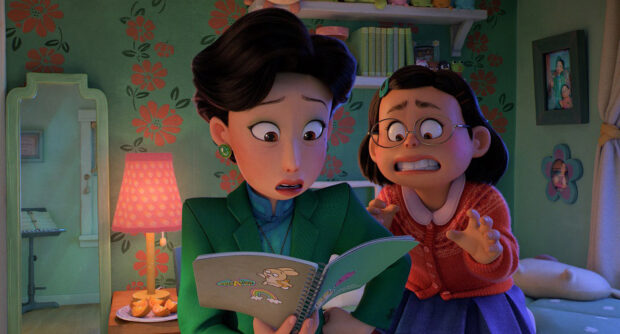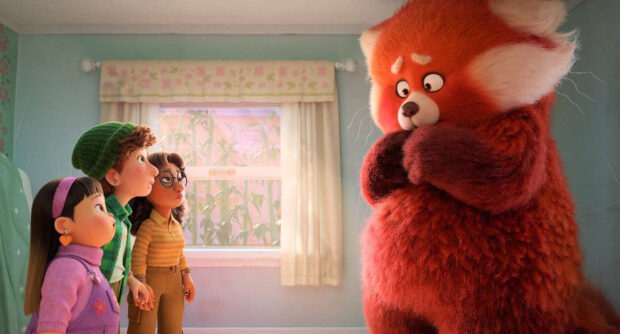Movie review: Turning Red’ is a charming Pixar story celebrating the beauty and chaos of puberty, parenting, and friendship

Pixar’s latest film, “Turning Red,” is a giant allegory for the beauty and chaos of female adolescence. It’s early 2000s setting resonates particularly with millennial women, but its core themes are universal: puberty, parenting, and the life-altering magic of friendship.
Debuting on Disney+ on Friday, March 11, the animated feature from Domee Shi, who directed the Pixar short “Bao” in 2018, is visually bold and bright with a rainbow-filled, glittery color palette that speaks directly to the explosiveness that is the transition from child to teen.
Its story feels both deeply personal and universally relevant — full of social and cultural details that honor adolescence, female friendships, and the often-fraught relationships between mothers and daughters.

“Turning Red” easily earns a special place in the Pixar canon. It has all the rich and compelling hallmarks of a Pixar feature, but tones down the studio’s penchant for deep sorrow in favor of celebration and joy.
Many of Pixar’s best films center around loss and sadness — like “Toy Story 2,” “Toy Story 3”, and “Inside Out.” In particular, the loss of a personal relationship with someone or the loss of youth. But in “Turning Red” the transition from child to 13-year-old isn’t a mournful one. Sure, there are plenty of awkward, cringey moments in Mei’s journey, but “Turning Red” largely celebrates early teenagerhood through its charming, moving story.
The Toronto-set film follows Mei (Rosalia Chang), a Chinese-American girl who just turned 13 and who is equally obsessed with overachieving at school, honoring her parents and family heritage, hanging out with her friends, and gushing over boy band 4*Town.
There are “two sides” to Mei — one side dedicated to her future and family and the other focused on typical teenage frivolity. As if her balancing act couldn’t get any more difficult, one morning Mei gets too excited and turns into a giant red panda.
She quickly learns her panda form is a bit of a curse, passed down through the female line in her family. For centuries, every woman in Mei’s family explodes into a big red panda when their emotions run high.

The scenes of her learning this life-upending bit of information are clear allegories for the tumultuous emotions of puberty. But “Turning Red” likewise doesn’t shy away from talking about periods.
Before Mei’s mother Ming (Sandra Oh) realizes the red panda situation, she guesses Mei is holed up in the bathroom distraught because she got her period for the first time. Mei does shout, “I’m a big red monster,” after all.
When she sees Mei covered in reddish-orange fur and sporting a huge fluffy tail, Ming tells her that she must permanently control and contain the red panda through an ancient magical ritual. Mei agrees, but quickly sees her panda in a new light, thanks to her friends. With her friends’ unwavering support, Mei begins to view her panda not as an embarrassment to hide, but something that brings joy and should be celebrated.
At its core, “Turning Red” is about conflicting loyalties — to Mei’s mother, to her friends, and, above all, to herself.
Chang and Oh are the brightest stars of “Turning Red,” deftly channeling the complex relationship between a stern, poised mother and a daughter who challenges her ideals. It’s not the cliche mother-daughter relationship often seen in movies, where there are heated arguments, door slamming, and harsh, hateful words. Mei and Ming’s relationship is so deeply rooted in love that even when they’re disagreeing you can’t help but root for both.
Both Mei and Ming have inner conflict — with the other person being both a catalyst and an anchor. Mei wants to dedicate time and energy to her family’s temple, honoring and celebrating her culture. But she also wants to embrace teenage independence, hanging out with her girlfriends, going to concerts, and gushing over boy bands. But even as Eastern tradition clashes with Western ideals, neither culture is made to feel like the “wrong” choice.
In the end, of course, Mei realizes she can and should embrace all “sides” of herself. And she shows her mom just how freeing it can be to unleash your inner panda.

Just as “Turning Red” embraces the dynamics of mother-daughter relationships, it triumphantly showcases the power of female friendships made in adolescence. The film features some of the most authentic and relatable relationships between teen girls I’ve seen in any film — animated or live action.
Mei’s friends — Miriam (Ava Morse), Priya (Maitreyi Ramakrishnan), and Abby (Hyein Park) — are enthusiastically and unconditionally supportive of Mei and each other. Their passion for 4*Town (whose incredible music was written by Billie Eilish and Finneas O’Connell) and entrepreneurial dedication to seeing the boy band in concert is key to Mei’s transformation into a young woman who empowers and embraces her emotions, especially feelings of joy.
“Turning Red” is meant for all ages, and like all other Pixar films, it knows what details to showcase and intimate moments to focus on to move us. What makes Shi’s film stand out from other Pixar flicks, however, is its vibrancy and optimism, lauding tough moments and emotions that showcase their relatability and complexity.
“Turning Red” is also downright hilarious and fun — from relating to Mei taking care of her needy Tamagotchi and her friends adoring her soft, cuddly panda form to starry-eyed teen girls screaming and crying at their first boy band concert. It’s easily one of Disney-Pixar’s best animated features in years.

